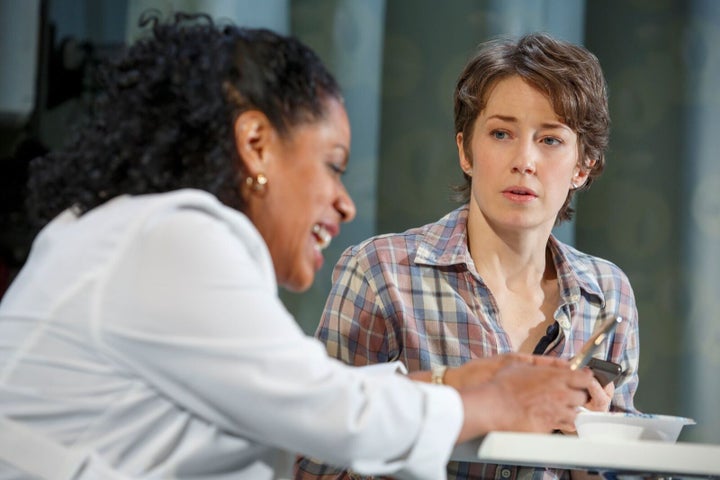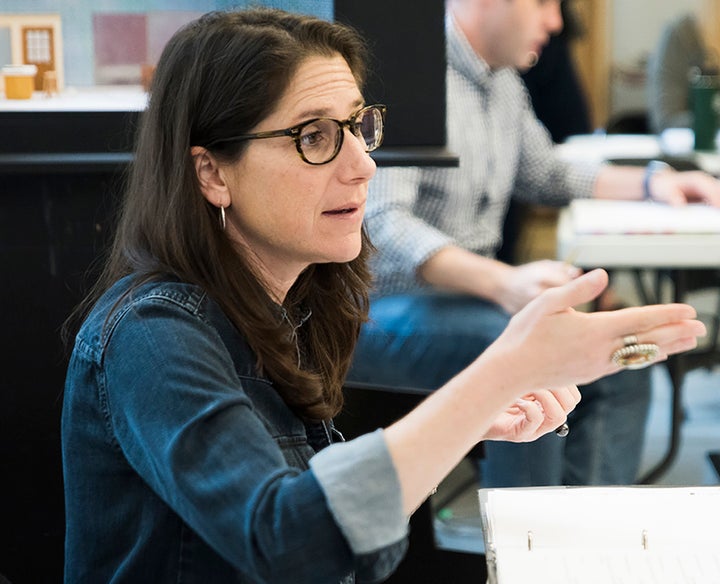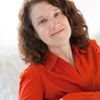
Mary Jane’s Liza Colón-Zayas and Carrie Coon
If you’re lucky enough to get tickets to Mary Jane, a heartbreaking comedy by Amy Herzog now playing at New York Theatre Workshop, you may emerge from the experience as I did, exhilarated and shaken. A flawless cast led by The Leftovers’ Carrie Coon brings to gorgeously odd life the story of a mother whose devotion to her son breaks the limits of reason, bleeding into something either mad or profound. Pairing a deceptive lightness with fearless emotional directness, this exploration of the heights and depths humans are capable of is layered atop ordinary details of daily existence in a way that feels both familiar and startling.
Mary Jane’s multiply award-winning director, Anne Kauffman, a cofounder of the Civilians theater group, has earned a reputation as a helmer skilled at creating the perfect stage language for boldly original works, including Detroit, Slowgirl and Maple and Vine. The director spoke with me by phone about past, present and future art.
Congratulations on the exquisite production of “Mary Jane.” It's a miracle when everything comes together so magically. Have you had that happen a lot?
Anne Kauffman: No, I have not had that happen a lot. And we theater people are just, we’re after that rush, you know what I mean? We kill ourselves to get that, and it's so infrequent that it happens. You wonder how we can stand the rest of the time.
What do you do when it doesn't happen—or do you always see glimpses of it?
I think so. If it’s worth it, it’s pursued, then there’s something—it sounds Pollyanna-ish, but there's a part of it that feels like that, hopefully. I would say it’s more rare for me to feel that there's nothing redeemable about a piece.
When did you first know that theater was for you?
I don’t think I’ve ever not known. I can’t remember, really, a time—I actually did stuff in grade school, and then I didn’t do any of it in high school, because I followed in my sisters’ footsteps—I’m one of six children, and I’m number five out of six, so I often say that probably my exhibitionism is a huge part of why I went [into it], and the need for attention. But when I was in high school, I was a cheerleader, I was in student government—I was one of those types.
Your exhibitionism may have led you to the theater as an actor, but directing is selfless. You’re giving yourself over to others, serving everyone else, the writer and the actors.
But we also like control, which I realize is another part of my personality. I think I figured out in college that I wasn't the star, the musical theater star, that I hoped I would be. I also found I sort of lost interest—just focusing on one thing grew dull to me. Something about the challenge of being responsible for the entire orchestration of things was the thing that actually really kept me engaged, and satisfied my need to dig in and organize and orchestrate and bring a vision—whatever that vision was—to life.
How did you come to directing?
I took a class in undergrad, I'm not sure why—it was terrifying to me. It's still terrifying, directing is a terrifying pursuit. It's an impossible thing that we do, and it's way overwhelming, and it's really the reason to do it too, like I said, it's really the thing that keeps me fully engaged, to be overwhelmed. I don't really understand why I started doing it, but I think I directed something in my dorm [at Stanford], and then I took a class, and I remember very distinctly the professor pulled me aside one day and said, "How does it feel to be a director?" And I found that astonishing, just out of control. Like some sort of mantle had been placed on my shoulders that was both exhilarating and hugely burdensome. It was a very exciting moment.
From school in California, how did you find your way to New York City?
I'm actually from Phoenix, Arizona. When each of us graduated from the eighth grade, my dad would take each of us, on our own, to our first trip back east, so he took us to New York City and Washington, D.C. And there were several things that we were put through in order to earn the trip. We had to memorize the preamble to the Constitution, the Declaration of Independence, the Bill of Rights. This was in the days when you could actually walk up the Statue of Liberty, so every night we'd do squats in my parents’ bedroom to get ready to go up. And in New York, every night and every matinee, we went to go see a show. I remember really not liking New York City because we went in the summer when it was very humid and disgusting and crowded and horrible. But when I went to the theater I was just, I was 13 years old and I already had aspirations. We would go home to the hotel after the shows and I would cry myself to sleep. I was very passionate about it—despite the humidity and the disgusting pollution and the stench at that time—that was 1982.
Is it strange to find yourself now doing the thing that transported you?
I think about this so much. I think about that girl and I think about how hard, how challenging the road is to become a director, I think about that every single day. I’m never far from it–I feel very close to not making it. It’s so precarious, because there truly is no path. The path to director, each of us is creating our own path, we’re trailblazing our own, because no one’s getting there the exact same way.
Particularly for women, it feels like it’s almost impossible to have opportunities.
There’s more of us who are in a greater position of influence, but yeah, definitely, the ratio is not what it should be, that’s for sure.
How did this project come to you? Is there some particular thing you look for in the plays you want to do?
In this particular instance, Amy Herzog and I worked together on a play called Belleville a few years ago. I establish relationships with playwrights, so pretty much if someone like Amy Herzog—and Amy Herzog in particular, I would say—comes to me with a play, I’m pretty predisposed to say yes. She’s such an extraordinary writer and just an extraordinary human being. She’s a very sly writer, because it seems as though she’s a mainstream writer, but in fact she’s quite experimental. This play is extraordinary on so many levels: she’s playing with so many different levels of genre and consciousness and pursuit and text. She’s an astonishing thinker and writer. Honestly, I had no idea—I was like, “Okay, Amy, sure, let’s do this play, this is a difficult play, it’s a difficult emotional play.” And even I who know Amy very well can take her work at face value, when in fact it has nothing to do with face value. It all lives underneath. So I didn’t really know what I was in for. When we did this at Yale, we did the production that I thought was there, and we did it well. Revisiting it—it’s extraordinary when you know you’ll have another chance; to have that second chance, which we got with Belleville too—it flowered in a completely different way. My interaction with it and its profound effect on me—it opened up even more. You know, the high holidays were this past week, and I haven’t been to synagogue, it’s got to be 10 years. And this year, after working on Amy’s play and talking to a very particular rabbi about the Hasidic woman in the play, I was like, “I need to go to synagogue!” [Laughs] Because the play is actually in such complex pursuit of spirituality and what it is to become—who you were, who you are now, and what it is to become in your next iteration—it made me go to temple!
I would get more meaning from the play than temple, but that’s just me.
The combination of going back to synagogue and having a very particular experience there, and merging how I felt like our rehearsals were like a kind of philosophical rumination—combining what it felt like in the rehearsal room with these particular women talking about the stuff that we were talking about, in conjunction with temple—this is going to sound very crazy, but I actually figured out, finally, my interpretation of God. [After] many, many years of people being like, “Do you believe in God? Do you believe in God?” and [my saying], “There’s probably a higher power, I don’t know what it is,” but completely avoiding and avoiding and avoiding it, suddenly it was like, “Oh, that’s what it is!” And it’s very simple and very clear to me, and very reassuring. [Pause] If I tell Amy I found God going to temple because of the show, she’s going to laugh at me.
I can see the play leading you to that conclusion. In essence it is a pure portrait of love and devotion. It’s so unwavering in its pursuit of what’s real, no matter how difficult; it looks it in the eye. One of the reasons Mary Jane is such a remarkable character is that she doesn’t flinch from anything. We’re accustomed to characters who are too cheerful in the face of horrors, we think of them as deluded, and Mary Jane is transcendent. She is fearless in everything she addresses, and naked in her emotions and honesty, and it leaves an indelible mark because it’s so powerful.

Director Anne Kauffman in rehearsal for Marvin’s Room
You just came off of directing Scott McPherson’s “Marvin’s Room” on Broadway. I remember seeing the original and thinking there were good things about it, but when I saw your production, I realized what a great play it is. I wasn’t prepared for how much I liked it, how both of your movie stars gave such beautiful performances, far beyond what I thought either was capable of. I didn’t even recognize the voices they were using, the lightness and the nuance—and of course the young man was remarkable. I know it probably did not do as well as it deserved to do. Did you feel a lot of pressure going into that production? Was it scary to go to Broadway?
You know, it’s funny, it was not scary. It’s taken me a long time to get there. It’s also nonprofit Broadway, so it has a different kind of feel to it—I haven’t done commercial Broadway, so I don’t really know. But it felt like a very comfortable graduation. You know, I came to New York when Marvin’s Room was originally produced in New York—I like to think that both Scott and I made our move at the same time [laughs]. That genre of theatre, that’s what I was raised on, the kind of wacky sense of humor, with darkness. He’s not quite as strange as Harry Kondoleon, but I feel like he shares the absurdity.
Grounded in emotion, addressing meaningful things.
So I was very happy to do that. Of course, my tastes have changed, and my sensibility is different, but I love the idea that I’m someone who directs Amy Herzog’s play and brings that sensibility to a Scott McPherson play that was done in the ’90s—because that’s what that production was for me; I felt like I was exploring the more ruminatory aspects of it. Also, doing that play right before doing Mary Jane—actually, that play was sandwiched between the Yale production of Mary Jane and the New York Theatre Workshop production of Mary Jane, so I was sort of dumped into the deep end of caretaking, and women who are caretakers. Putting caretaking and disability at the center of a piece and looking right at it is something that we do not do in this country, and Scott McPherson, by gosh, he did that. He did. Laura Jellinek, who did the set for A Life and for Marvin’s Room and for Mary Jane, we were laughing, because we were working on two shows where a character who is ill is behind a wall. And what you experience are the reverberations of that human being who is so deeply loved by the people that we’re actually seeing roam around the stage. You see that person very much in the DNA of the people we’re looking at, but it’s not about that person, just like Mary Jane’s not about [her son] Alex, it’s about Mary Jane.
If you could do anything at all, what would it be?
I would like to revisit Spring Awakening, the actual play. The play is so much darker than the musical. It has everything that I love about the theater in it. Another thing I’m working on very passionately and diligently is to bring The Sign in Sidney Brustein’s Window, the Lorraine Hansberry play that I did in Chicago, to New York. It’s a beautiful play.
I don’t know it at all. What’s your next adventure?
I’m doing the next show at the New York Theatre Workshop, which is a theatrical concert called Hundred Days by the Bengsons, who are a husband-and-wife composing-musician team. And then we’re doing their next project at Ars Nova in the winter. They’re an extraordinary duo, and they make beautiful work. And it continues in the tradition of the darkness that I explore.
The dark time we’re living in is so surreal. Each day somebody dies too young, I think, “Trump killed him/her,” because the added stress and aggravation and horror and anxiety, I just feel, is pressing down on all of us. Does it ever seem like doing art is a luxury we can’t afford in these dire times?
I find that art is a pretty important part of the ecosystem of a society. I think of it as a necessity. I don’t think my work can change the world, but I think it’s a necessary part of the conversation. I said yesterday to a group of people: “I’m so lucky, because I’m not a policymaker, I don’t have to make policy, I don’t have to make decisions. But what I do do, what I’m committed to doing is presenting and reminding people of the complexities of who we are as human beings, so that when those policymakers are making those policies, that they remember, they look before they leap.” That is, I think, the role of art—to remember ourselves to us, and to complexify things that are so black-and-white. Certainly Trump is making things black-and-white. But in order to make a decision, things have to kind of come down to a black-and-white situation. Gradations of gray are a difficult thing, but they have to go into the decision-making. And that’s what I think art does. It remembers that.
